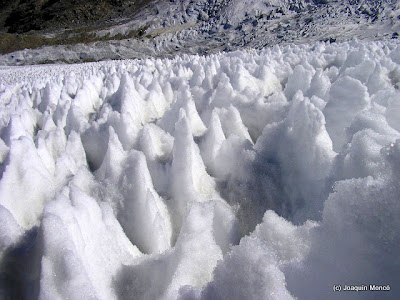 |
| McKinley aproximándose a vuelo de avioneta |
Llegar a Talkeetna por carretera desde Anchorage, aunque empresa sencilla por el buen asfalto que serpentea entre las corrientes glaciares, ya me supuso una emoción trémula. Era en cierto modo como llegar a Chamonix, a Huaraz o a Namche Bazaar, salvando las kilométricas distancias; tocar a la puerta de las grandes montañas, el hogar de los dioses y las leyendas, de los sueños adultos. El mínimo pueblo me recibió con un poderoso mandoble de sol y calor estival en el corazón de Alaska convirtiendo el nombre saboreado tantas veces en mapas y libros en un golpe de profunda realidad.
Tras comer en la famosa Roadhouse y contemplar las fotos de sus paredes, me decidí de una vez a no posponer el encuentro y a enfrentarme con el gigante, aunque fuera tímidamente y en la distancia. Apenas a unos pasos del pueblo, por un camino entre árboles y vallados, desemboqué en una playa de piedras donde el agua del río Talkeetna saltaba en perlas de luz. Al fondo, como una acuarela al sol, casi un espejismo de beduino, se extendía la trilogía de grandes montes que reinan sobre otros súbditos en el Denali National Park: Hunter, Foraker y, muy por encima, el monarca McKinley, el Denali.
Con el zumbido de los motores de una avioneta en los oídos pude sobrevolar boquiabierto el descomunal castillo de torres, fosos y almenas que levantan los hielos y piedras del macizo del Denali, ser insecto en un mundo de dragones, pero ésa es otra historia que merece otro capítulo.
Un día después, desde el flanco norte de la montaña por el que discurre la única carretera que se adentra en el parque, el Denali se había ocultado ya a la vista de los mortales. Con un atisbo basta, no sea que acabemos abrasados como Semele por el fulgor divino. Por encima de las frías aguas que se derramaban desde el glaciar Muldrow sólo había nubes violetas y olor a lluvia.
(Alaska, agosto de 2009)
 |
| Trilogía: Hunter, Foraker y Denali desde las aguas del Talkeetna |
 |
| Denali o McKinley desde Talkeetna |
 |
| Cumbre del Denali a vuelo de pájaro |
 |
| El Denali y el Foraker desaparecen en la penumbra |
********
A SUNNY DAY (DENALI, ALASKA)
Reaching Talkeetna by road from Anchorage, although an easy venture due to the good asphalt that meanders through the glacial streams, it was a tremulous emotion for me. It was somehow as getting to Chamonix, Huaraz or Namche Bazaar, apart from the kilometric distance, as knocking on the great mountains' door, home of the gods and legends, of adult dreams. The tiny village greeted me with a powerful blow of sun and summer heat in the heart of Alaska turning the name so often savored on maps and books into a stroke of deep reality.
After eating at the famous Roadhouse and watching the photos on its walls, I decided not to postpone the meeting and face the giant, albeit timidly and in the distance. Just a short walk from the village, along a path between trees and hedges, I arrived to a pebble beach where Talkeetna River water jumped in pearls of light. In the background, like a watercolor in the sun, almost a Bedouin mirage, strechted the trilogy of great mountains reigning over other subjects in Denali National Park: Hunter, Foraker, and high above the monarch McKinley, Denali.
With the hum of a light aircraft's engines in my ears, I could fly astonished over the colossal castle of towers, moats and battlements that raise Denali massif's ices and stones, be insect in a world of dragons, but that's another story that deserves other chapter.
One day later, from the mountain's northern flank along which runs the only road that goes into the park, Denali was hiding for people's sight. Just a glimpse enough, lest we end up burned by the divine brightness as Semele did. Above the cold waters spilling from the Muldrow Glacier there were only violet clouds and smell of rain.
(Alaska, August 2009)
(c) Copyright del texto y de las fotos: Joaquín Moncó




























